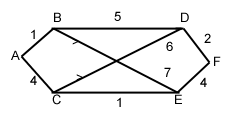Real-Life Math
Computers don't think like we do. The human brain can do multiple
parallel calculations at one time; we can look at a face and simply recognize
it. A computer, on the other hand, would have to consider a number of qualities
about that face one at a time in order to identify it. For example:
IF
man has brown eyes
AND mole on left cheek
AND scar on
chin
AND crooked front tooth
Conclusion = Bob
The
challenge for you as a knowledge engineer is to take real-life problems and
break them down into qualities that a computer can understand. You work for
a company that is perfecting an online mapping system for vehicles -- you
enter a destination into a computer in your car and it tells you the best
way to get there. Each possible route to your destination has to be given
a value. The value might be based on the distance traveled, the number of
stoplights or the number of hills along the route. Think of this as the cost
of travel.
If you look at the map diagram below, you can quickly see
that the least costly way to get from A to F is A to B to D to F:

Mathematically it looks like this:
1 + 5 + 2 = 8
A computer arrives at the same conclusion through an entirely
different method. It has to systematically compare the cost of each route
before it can select an appropriate course. Your job as a knowledge engineer
is to program the computer with a step-by-step procedure for
making the calculation -- otherwise known as an algorithm.
Here's what
your algorithm should include:
- Three columns
- The first representing a letter, or point along the route (called a node)
- The second representing the cost of traveling to that node from A
- The third naming the node that immediately preceded it
OK, now you fill it in. The program won't work until you do! What
is the greatest cost of getting to F -- keeping in mind that the arrows allow
for one way travel only? Your first and second entry will look like this:
| Node | Cost | Predecessor |
| A | 0 | - |
| B | 1 | A |
The cost of going from A to A is nothing and the predecessor is
blank because you're already there. The cost of going from A to B is 1 and
the predecessor is A because you've gone from A to B. Got it? Fill out the
rest of the algorithm and you'll have an answer you and the computer can understand!